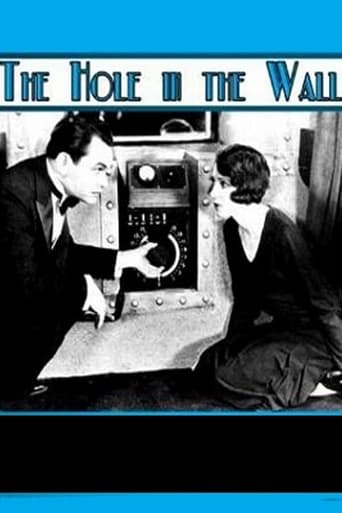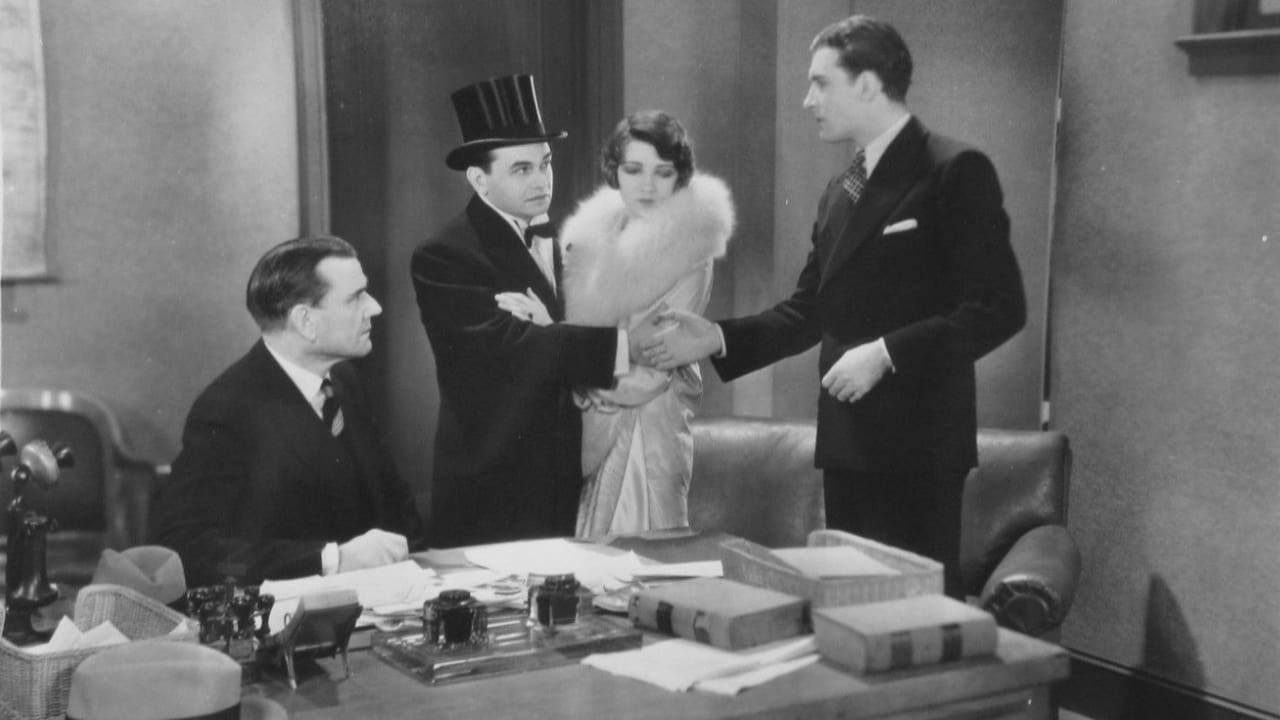touser2004
Poorly lit and poorly written but interesting from a historical perspective.You can watch on You Tube under The Charlatan. Colbert is young and not as confident as in her later films Robinson only shows glimpses of his gangsta persona but it is still interesting to watch The plot is very simple and unbelievable.
ackstasis
Robert Florey began his career with a number of celebrated silent avant garde shorts films – including 'The Love of Zero (1927)' and 'The Life and Death of 9413, a Hollywood Extra (1928)' – all strongly indebted to 'The Cabinet of Dr Caligari (1920)' and German Expressionism. Therefore, it's a little disappointing that his features aren't all that interesting. 'Murders in the Rue Morgue (1932)' was visually stunning, thanks largely to cinematographer Karl Freund, but was stunted by ham- fisted acting and bad dialogue (perhaps a side-effect of the director's poor command of English). 'The Hole in the Wall (1929),' bound by the restrictions of early sound technology, even lacks Florey's usual visual flair – the only exception is the entrance to Madam Mystera's haunt, which has the warped ceiling of a 'Caligari' set. Perhaps the primary interest here is the film's cast, which includes two future stars in their first talkie.The story itself is vaguely interesting: a shrewd shyster called The Fox (Edward G. Robinson) recruits a wrongly-accused ex-con (Claudette Colbert, in her second role) to help perpetrate a Spiritualism scam. (Spiritualism was all the rage in the 1920s, its greatest proponent being author Arthur Conan Doyle, who used his Professor Challenger character to promote the field in his 1926 novel "The Land of Mist"). Unfortunately, there's very little tension in this film. The possible drowning of a little girl should have made for suspenseful storytelling, and Florey was generally an expert at editing rhythmic montages, but here there's no urgency in his cross-cutting, and the dialogue unfolds with unnatural slowness, as though to make certain that the sound equipment is catching everything. Finally, I was very much surprised that, after an hour of exposing Spiritualism as a fraud, the film suddenly tosses in an authentic psychic moment, and nobody thinks twice about it.
HarlowMGM
THE HOLE IN THE WALL is a crime melodrama where only one gun is seen fleetingly. Edward G. Robinson stars as "The Fox", leader of a small gang who has found a new racket that's a cinch, running a fake spiritual medium which finds out information about the belongings of rich believing clients which he then steals. When his "Madame Mysteria" is killed in a railway crash (an incredibly cheap "special effect" badly done with toys which even 1929 audience must have laughed at) he is without a female front for the organization. Within hours into the dungeon-like headquarters/business walks Claudette Colbert, fresh out of jail after being falsely accused of theft. Unable to find a job, she comes the headquarters having heard she might could find a place in the racket from sources she knew in the slammer. Robinson immediately sees her as his new medium and after a practice bit, she agrees to do it - in exchange for her own illegal scheme - she wants to kidnap the granddaughter of the woman who framed her and keep her, raising her as a crook she was accusing of being.This 1929 melodrama is quite bad and yet rather interesting. This is mainly thanks to top-billed Claudette Colbert, clearly a natural for films, she gives a smooth performance in a highly wavering film. Edward G. Robinson does come not off quite as well and he is hampered by the heavy makeup often given men in mediocre early talkies, black lips and all. It's easy to see why Paramount kept her and passed on him. The big surprise is David Newell, the second lead, who does a very competent job as the good-looking young reporter who turns out to have been an old beau of Claudette's. Newell is very much the type of leading man Paramount loved - he definitely foreshadows Ray Milland and Fred MacMurray - yet his stint as a Paramount player was brief (he appears to have been let go during the massive cutbacks of late 1930 which saw Jean Arthur, Mary Brian, and many other secondary performers canned at the studio.) Newell was playing small parts in 1932 and by 1933 he was beginning an extremely long career as an unbilled bit player.Meek character actor Donald Meek makes a rather unconvincing gang member and then there is a character supposedly purchased from a freak show named "Dogface" who is kept around inexplicably since he never really has anything to do in the story. Louise Closser Hale's grande dame is written so imperviously she's barely given pause to the fact that her granddaughter is missing with no leads. Actress Nellie Salvage, a minor player in silent films, has her only talking role as the ill-fated Madame.The print I viewed was in quite good shape, however it ran only 63 minutes although there was no continuity problem suggesting it may have never been the 73 minutes IMDb lists it at. The movie is also a complete talkie, although there are a few seconds of non-sound when characters appear to be conversing but this was probably dropouts in the print.The movie ends somewhat abruptly, as often appears to be the case in early Paramount talkies. The set designer and cinematographer do a considerably better job creating a fairly spooky, creepy ambiance than does director Florey. Worth seeing only as a curio - or for fans of the cast.
F Gwynplaine MacIntyre
"The Hole in the Wall" is an early part-talkie, well-directed by Robert Florey but saddled with a plot that Tod Browning might have cooked up for Lon Chaney on a bad day. Several themes beloved of Browning (and often used in Chaney's movies) are prominently used here, including a gang of crooks and phoney mediums, and (shades of "West of Zanzibar") a plot to corrupt an innocent girl in order to get revenge on her parent. The "hole in the wall" in this movie's title is in the crooks' hideout: it's a peephole with a periscope, which the phoney medium uses to spy on her victims, so that she can gain information about them before she meets them, and impress her victims with her "psychic" abilities.Claudette Colbert (still learning the techniques of film acting) stars as Jean Oliver, who was sent to prison on false testimony by snooty society dame Mrs Ramsay. After spending several years in prison, now Jean is out and hell-bent on revenge. She plans to kidnap Mrs Ramsay's little daughter Marcia, and raise the girl as a thief in a Fagin-like environment. Jean hopes that Marcia will grow up to be an habitual thief, get arrested and acquire a criminal record ... and then Jean will get her revenge by revealing herself to Mrs Ramsay as the person responsible for her daughter's corruption.The climax of the film is meant to be very exciting, when little golden-haired Marcia is a prisoner in the dockyards, trapped on a quayside ladder while the tide rises. Unfortunately, the untalented child actress who plays the kidnap victim keeps screeching "Mama! Mama!" over and over, on a very bad soundtrack. We're supposed to be concerned about the plight of a kidnapped child who's in danger of drowning, but I kept wishing the brat would shut her gob and quit yapping.The soundtrack is VERY bad, and I don't think it's just because I saw a very scratchy old print of this film. In the late 1920s and early 30s, the Fox Movietone method of sound recording (which this film uses) was vastly inferior to the Vitaphone process used by Warner Brothers. I give credit to director Florey and his screenwriter (Pierre Collinge) for intelligently shaping the story to incorporate sound effects legitimately, at a time when many part-talkie films used sound effects merely for stunt purposes. But the dialogue is badly written, apart from its poor sound fidelity. Groucho Marx, who worked with the French-born Florey in "The Cocoanuts" later this same year, claimed that Florey had difficulty speaking English ... which might explain why Florey allowed such wretchedly bad dialogue to get past him in "The Hole in the Wall".There's an exciting scene of a train crash on an elevated railway, and throughout the film the photography is excellent, as are the lighting and the shot-framing. This film's many good points outweigh its numerous bad points.


 AD
AD


